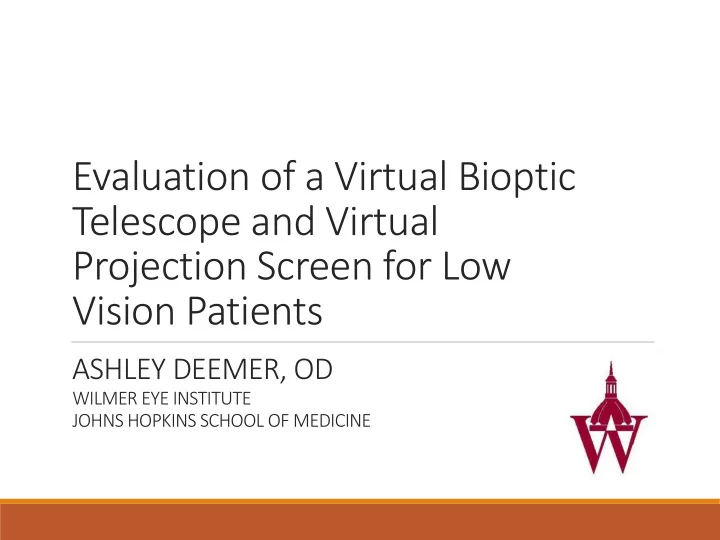

Evaluation of a Virtual Bioptic Telescope and Virtual Projection Screen for Low Vision Patients ASHLEY DEEMER, OD WILMER EYE INSTITUTE JOHNS HOPKINS SCHOOL OF MEDICINE
Disclosures I have no financial disclosures Visionize, LLC was involved in providing equipment for the study
Purpose § Magnification is used to compensate for reduced visual acuity § Using a head-mounted display equipped with a high- resolution video camera, we can employ virtual reality methods to magnify images in real time § Existing head-mounted display units magnify the entire view and with high levels of magnification, image movement becomes problematic § Here we test a virtual bioptic telescope and virtual projection screen as an innovative approach to magnification
Iris Vision
Virtual Bioptic
Virtual Projection Screen
Home Trial • Observational study – aimed to determine if these approaches to magnification are beneficial to low vision patients performing ADLs • 30 participants were recruited from the Low Vision Center at the Wilmer Eye Institute • 13 female, 17 male • Mean age 53 years old, Age range 19-93 • BCVA <20/100 in the better-seeing eye • Acuity ranged from 20/100 to 20/400 • Bilateral central scotomas with normal peripheral VF
Home Trial • All participants had prior exposure to low vision services and were experienced visual assistive equipment users • The participants had basic operational training for 30-45 min in clinic • Then took the system home for a 7-10 day trial
Outcome Measures • The Activity Inventory (AI) was administered before and after the home-trial to measure effect on self-reported visual function • Simulator sickness questionnaire and system-use survey were administered twice by telephone during the trial period • Baseline and follow-up AI results were analyzed using a Rasch model
Results – Effect Size 1.4 1.2 1 0.8 Effect Size 0.6 0.4 0.2 0 -0.2 Goals Reading Mobility Vis Info Vis Motor Outside Inside Home Home Visual Abiliity Domain
Results – Minimal Clinically Important Difference (MCID) MCID frequency % of participants Domain Goals 69.0% Visual Info 86.2% Reading 85.7% Outside Home 78.6% Inside Home 72.4% Mobility 45.5% Visual Motor 44.0%
Simulator Sickness Questionnaire
Simulator Sickness Questionnaire • 5 patients (17%) reported headache • 4 patients (13%) reported symptoms of nausea • 11 patients (38%) reported experiencing eye strain • 7 patients (24%) “barely” • 2 patients (7%) “moderately” • 2 patients (7%) “very”
System-Use Survey • Each participant was asked “How useful did you find the device?” • The average ordinal patient rating was 7.14/10 • 17 (57%) of the patients said they would be interested in purchasing the device for their personal use
Conclusions • The use of this virtual bioptic system / virtual projection screen resulted in improvements in visual function in the following domains: • Visual Information • Reading • Outside the home tasks • Inside the home tasks • Goals • The system was not effective for improving mobility and visual motor function
Conclusions • Overall, this group of experienced visual assistive device users found this method of magnification to be effective in their daily activities • Over half of the participants found the device to be useful enough to consider purchasing • A small, but significant number of participants reported symptoms of discomfort while using the device
Thank you Collaborators: Bob Massof Contact Information: James Deremeik Ashley Deemer Chris Bradley adeemer1@jhmi.edu Kyoko Fujiwara Frank Werblin Nicole Ross Danielle Natale Visionize, LLC Reader’s Digest Partners for Sight Foundation Grant
Recommend
More recommend